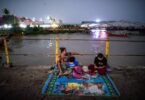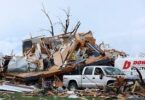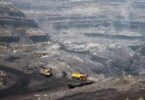Roberval (BBC): Hazardous smoke from Canadian wildfires blanketed the skies in large parts of North America last week. The government says the country as a whole is on course for its worst year for wildfires on record.
In the province of Quebec, over 120 fires are burning, and fire crews are battling an element that always surprises. Six in the morning is not long gone, but work has already begun on Saturday in a nondescript two-storey office building in Roberval, a town of some 10,000 people in south-central Quebec.
That’s where the next 24 hours are being strategised in a fight against wildfires, a battle waged in increments and by the hour.
“A fire is alive, an uncontrollable element that we’re trying to control,” said Patrice Charest.
The 43-year-old, with a sleeve of tattoos, a canvas cowboy hat and a bushy red beard has been fighting fires for 20 years. He has been working 12-to-14-hour shifts for 19 days straight, without a break.
Firefighting water bombers – planes fitted with large water tanks – stand at the ready outside, along with helicopters to ferry on-the-ground fire crews to blazes burning in the regions north, east and west of the town. Inside the building, about 100 people with the provincial firefighting agency, the SOPFEU, are tracking the behaviour of each fire and the weather that could help or hinder their work.
That information will help them decide where to deploy strained resources like Mr Charest and his crews. “I execute – I’m the soldier, they send me to war,” the firefighter said. His nemesis in recent days has been Fire 236, a 7,000 hectare (17,300 acre) blaze, now contained, that was threatening homes near the municipality of Notre-Dame-de-Lorette. He’d hoped for 25 crew, but with over 120 fires burning in the province – over 728,000 hectares have burned this year to date, compared to the 2,147 hectare 10-year average – he understands why he’s forced to make-do with just 12.
They’ve slowed the fire’s progress – on an aerial image, there’s a scar of blackened ground but no visual smoke and flames. But work on 236 is not done.
No flames does not mean the fire is out. Crews will be looking for fires that burn below ground in a layer of decaying roots, dead leaves and bark, that produce little to no smoke.
With experience, a firefighter like Mr Charest can detect the scent of the plumes of smoke produced by that type of fire. “You look for it, put your nose to the wind,” he said. It’s a unique smell but one he struggled to describe.
A helicopter will scan the fire zone for hot spots and the crew will head to the scene later. “My guys will patrol the entire fire, inspect each square meter,” he said.
Earlier this year, Mr Charest was in the western province of Alberta, which declared a state of emergency in early May as fires prompted several evacuation orders.
Then overnight on 1 June, lightning in Quebec sparked around 200 fires overnight, said Frédéric André, the regional director at Roberval. Quebec was forced to call back its firefighters in other provinces and put out its own call for extra hands.
But with fires burning in Alberta, British Columbia, Nova Scotia and other regions, “nothing was left in Canada”, he said.







